Drone soccers are small quadcopters inside a light plastic cage with LEDs for safe bumps and easy team color ID. They all have four rotors and come in two sizes: Class 20 drones use ~200mm cages and weigh under 300g, while Class 40 drones use ~400mm cages and weigh up to 1200g. As drone soccer grows in schools, tournaments, and STEM programs, picking the right battery and charger is key to reliable, winning play.
Soccer drones are essentially mini-quadcopters enclosed in a lightweight spherical frame, enabling safe mid-air collisions and easy identification via onboard LED lighting. Class 20 drones feature a 20cm ±1 cm cage and weigh under 300g (battery and outer frame included ), while Class 40 drones use a 40cm ± 2cm cage and weigh up to1.2kg including power equipment. Both classes employ four-motor electric propulsion and 2.4GHz RC control, with full-contact play allowed within netted indoor arenas or suitably protected outdoor fields World Air Sports Federation.
Matches are split into three sets of three minutes each, with a brief maintenance interval between sets for drone repairs or battery swaps World Air Sports Federation. Each team fields five pilots but only one designated “striker” may score by flying through the opponent’s elevated goal ring (30cm inner diameter for Class 20; 60cm for Class 40). Victory is determined by winning two sets, with sudden-death overtime if tied. Drone balls must include fail-safe devices, LED identification capable of at least four colors, and obey strict weight/size tolerances (±1% measurement accuracy) World Air Sports Federation.
●Voltage & Cell Count
Pack voltage: 3S or 4S LiPo only, with 4S nominal ≤ 17.0V (no-load).
Cells per pack: 3S (11.1V) or 4S (14.8V) configurations; 4S gives higher top speed at the cost of slightly more weight.
●Voltage per Cell
Max cell voltage: 4.25V fully charged; storage voltage: ~3.85V per cell.
●High Discharge Rate (C-Rating)
Class 20: ≥ 75C continuous for instant throttle response in compact frames.
Class 40: ≥ 95C (often 120C) to sustain heavier loads and longer hover times.
●Capacity
Class 20: 650 mAh (4S) or 850 mAh (3S) recommended (≈ 2–3 min flight).
Class 40: 3000–4500 mAh typical.
●Weight & Size Tolerance
Pack weight & dimensions must be within ±1% of declared values, per FAI F9A tolerances.
●Connectors
Class 20: XT30 main connector;
Class 40: XT30 or XT60 (more common for higher current);
adapters (XT30⇄XT60) are widely available for flexibility.
●Safety & Durability
Fail-safe & protection: pack must include over-voltage cutoff or auto-shutoff; robust hard-case to withstand midair collisions.
Handling: follow LiPo safety best practices (storage, charging in fire-safe bag, supervised charging).
Founded in 2013 under the Grepow umbrella, Tattu was created to supply professional-grade LiPo power to the drone, FPV, and modeling hobby markets. With global offices in the US, Germany, and China, we support fast distribution and responsive technical service worldwide;
●Automated Stacking Process
Our proprietary lamination (stacking) technique reduces internal resistance, enabling higher discharge efficiency and lower heat generation under load;
●Al Boehmite Cell Coating
Tattu is the first brand to apply Al Boehmite treatment on FPV battery cells, boosting cycle life and power consistency during rapid discharge cycles
Tattu FPV Batteries offer three distinct series to match every drone-soccer requirement:
Standard Series (45C–95C) LiPo
Reliable, cost-effective packs in multiple capacities, ideal for entry-level and quick-turn matches.
Optimized for freestyle training and extended practice, balancing stable power output with affordability.
R-Line Series (Up to 150C) LiPo
Our top-end racing cells, featuring the highest discharge rates for peak thrust and responsiveness, trusted by world-champion pilots.
Class 20 Battery
Class 40 Battery
Drone Soccer Charger
Brand & Model | Capacity | Nominal Voltage | Fully-Charged Voltage | Discharge Rate | Dimension(±5mm) | Weight(±5g) |
Tattu Standard 2S1P | 450mAh | 7.4V | 8.4V | 95C | 45×24×15mm | 28g |
Tattu R-Line 1.0 3S1P | 650mAh | 11.1V | 12.6V | 95C | 60×31×19mm | 60g |
Tattu R-Line 1.0 3S1P | 750mAh | 11.1V | 12.6V | 95C | 60×31×21mm | 62g |
Tattu Standard 3S1P | 850mAh | 11.1V | 12.6V | 45C | 60×30×22mm | 74g |
Tattu Standard 3S1P | 850mAh | 11.1V | 12.6V | 75C | 59×30×24mm | 85g |
Tattu R-Line 1.0 3S1P | 1100mAh | 11.1V | 12.6V | 95C | 62×27×25mm | 80g |
Tattu Standard 3S1P | 1300mAh | 11.1V | 12.6V | 45C | 72×35×23mm | 114g |
Tattu R-Line 1.0 4S1P | 550mAh | 14.8V | 16.8V | 95C | 66×19×28mm | 60g |
Tattu R-Line 1.0 4S1P | 650mAh | 14.8V | 16.8V | 95C | 61×31×25mm | 82g |
Tattu R-Line 1.0 4S1P | 750mAh | 14.8V | 16.8V | 95C | 60×31×28mm | 82g |
Tattu R-Line 1.0 4S1P | 850mAh | 14.8V | 16.8V | 95C | 61×31×31mm | 105g |
*Connector: XT30
Brand & Model | Capacity | Nominal Voltage | Fully-Charged Voltage | Discharge Rate | Dimension(±5mm) | Weight(±5g) |
Tattu 100C 4S1P | 2600mAh | 14.8V | 16.8V | 100C | 95×35×30mm | 267g |
Tattu 100C 4S1P | 2800mAh | 14.8V | 16.8V | 100C | 107×35×37mm | 270g |
Tattu 100C 4S1P | 3000mAh | 14.8V | 16.8V | 100C | 107×35×39mm | 290g |
Tattu FUNFLY 6S1P | 1300mAh | 22.2V | 25.2V | 100C | 75×36×44mm | 225g |
Tattu R-Line 3.0 6S1P | 1550mAh | 22.2V | 25.2V | 120C | 77×39×48mm | 256g |
Tattu R-Line 5.0 6S1P | 1800mAh | 22.2V | 25.2V | 150C | 77×38×46mm | 287g |
*Connector: XT30, XT60
The iMars D300 300W smart charger supports 1-6 cell LiPo and LiHV batteries, with AC input and max charging current of 16A×2, offering users more flexible charging options. Suitable for RC models, FPV, and drone soccer, the D300 includes comprehensive protection features such as over-temperature, over-current, overcharge and reverse polaarity protection to ensure charging safety.

*Discover more RC / Drone Battery Chargers: Lipo Battery Charger